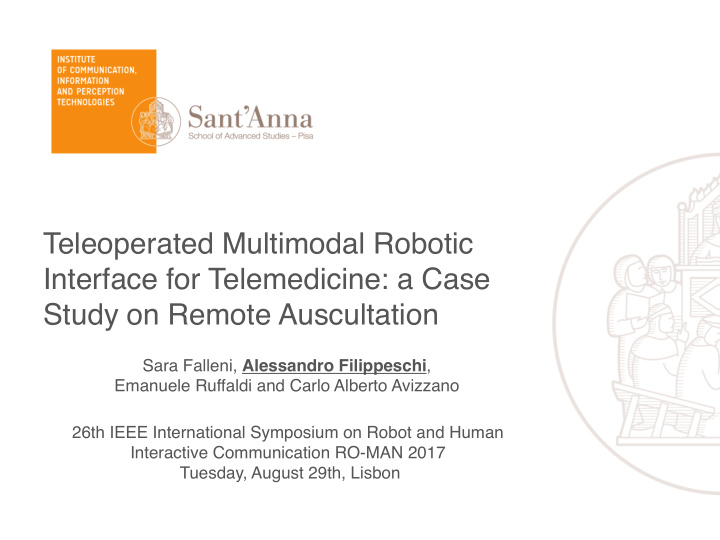



Teleoperated Multimodal Robotic Interface for Telemedicine: a Case Study on Remote Auscultation Sara Falleni, Alessandro Filippeschi , Emanuele Ruffaldi and Carlo Alberto Avizzano 26th IEEE International Symposium on Robot and Human Interactive Communication RO-MAN 2017 Tuesday, August 29th, Lisbon
Introduction and motivation • Population is aging in all developed countries • Increased need for examinations • Shortage of specialists • Situations in which examinations are required, but specialists are not available Countries with limited Healthcare systems • Countryside • War scenarios • Telemedicine is a valuable answer to these problems, problem tackled within the ReMeDi project Auscultation is one of the most common and important exams for patients screening Importance of investigation of robotics technologies for teleauscultation, in particular the role of haptic feedback 26th IEEE International Symposium on Robot and Human Interactive Communication RO-MAN 2017, Tuesday, August 29th, Lisbon
State of the art Most of the telemedicine systems focus on • videoconference, i.e. exploitation of visual and auditory channels, this applies also to auscultation Examinations is mediated by an assistant, • who is often a crucial medium of the specialist during the examination • Whereas haptic feedback is explored in other examinations (e.g. palpation and ultrasonography), the role of haptic feedback in teleauscultation has not been explored. 26th IEEE International Symposium on Robot and Human Interactive Communication RO-MAN 2017, Tuesday, August 29th, Lisbon
Multimodal Telauscultation System Doctor Site Patient Site RGB-D Camera Stethoscope End-effector Stethoscope COMM Chestpiece 26th IEEE International Symposium on Robot and Human Interactive Communication RO-MAN 2017, Tuesday, August 29th, Lisbon
Patient Site Bluetooth Sthetoscope • (Littmann 3200) chestpiece • Custom designed mechanical attachment • 3 DOFs robotic interface which features accurate force rendering and sensing Force limited to 4N for • the safety of the patient • RGB-D Camera for 3D scene reconstruction • Embedded controller PC-PAT • 26th IEEE International Symposium on Robot and Human Interactive Communication RO-MAN 2017, Tuesday, August 29th, Lisbon
Doctor Site 3 DOFs haptic interface • • Force limited to 20N • Translational motion of the EE • Speakers and stethoscope diaphragm LCD Screen • • PC-DOC • Embedded controller Joystick • 26th IEEE International Symposium on Robot and Human Interactive Communication RO-MAN 2017, Tuesday, August 29th, Lisbon
Teleauscultation system architecture HW (green) and SW (blue) components in the architecture of the teleauscultation system Three layers for the three sensory channels 26th IEEE International Symposium on Robot and Human Interactive Communication RO-MAN 2017, Tuesday, August 29th, Lisbon
Model for haptic rendering in teleoperation Model of the patient at the doctor site for force rendering FG, P0 and the ideal plane are recorded when the stethoscope touches the skin and force exceeds 4N Interaction force at the doctor site is calculated as Algorithm tested under small time varying latency (average 8.9ms, 75th percentile 50ms, peak 200ms) 26th IEEE International Symposium on Robot and Human Interactive Communication RO-MAN 2017, Tuesday, August 29th, Lisbon
Assessment of the system Rationale • Assess whether the system allows users to carry out auscultation-like tasks Assess whether haptic feedback has a role in the positioning of • the stethoscope Participants Ten inexperienced users (27.1 ± 2.51 years) • Materials • Teleauscultation system A second LCD screen at the doctor site • • Mannequin as virtual patient • Audio player and speakers inside of the mannequin 26th IEEE International Symposium on Robot and Human Interactive Communication RO-MAN 2017, Tuesday, August 29th, Lisbon
Assessment of the system Tasks and Metrics Tas Description Metric of error k 1 put the chestpiece of the Euclidean distance between the stethoscope on six targets placed on correct position and the the patient’s trunk as accurately as stethoscope position claimed possible by the participant 2 put the stethoscope on Absolute value of the target 4 and listen to the audio difference between the correct stream from the chestpiece by frequency and the one stated means of the headset. by the participant Participants have to estimate the heart frequency they hear 3 listening to ten pairs of tracks by 5 points Likert scale to give means of the stethoscope’s headset. their preference, one meant Participants are asked to rate which track one is totally preferable of the two tracks is better in terms of to track 2, 5 means total absence of noise and of overall sound preference quality. Tracks recorded manually or towards track 2 aided by the teleauscultation system. 26th IEEE International Symposium on Robot and Human Interactive Communication RO-MAN 2017, Tuesday, August 29th, Lisbon
Teleauscultation system and its assessment 26th IEEE International Symposium on Robot and Human Interactive Communication RO-MAN 2017, Tuesday, August 29th, Lisbon
Results Task 1 Error depending on haptic Timeseries of a participant feedback and target point during task 1 26th IEEE International Symposium on Robot and Human Interactive Communication RO-MAN 2017, Tuesday, August 29th, Lisbon
Results Tasks 2 and 3 Task 2 results. Error depending on Task 3 results. Preferences haptic feedback and HR frequency distribution 26th IEEE International Symposium on Robot and Human Interactive Communication RO-MAN 2017, Tuesday, August 29th, Lisbon
Conclusions and Future Work Conclusions The features of the systems were shown and demonstrated • through experiments with inexperienced participants. The system allows the user positioning the stethoscope and to • listen to the noises from the patient site fruitfully. No clear conclusions on the role of haptic feedback in • teleauscultation Future work Improvement of visualization system (e.g. VR) • Deeper investigation of the role of haptic feedback • Test of the system under larger communication delay and jitter • 26th IEEE International Symposium on Robot and Human Interactive Communication RO-MAN 2017, Tuesday, August 29th, Lisbon
Any Questions? 26th IEEE International Symposium on Robot and Human Interactive Communication RO-MAN 2017, Tuesday, August 29th, Lisbon
Recommend
More recommend